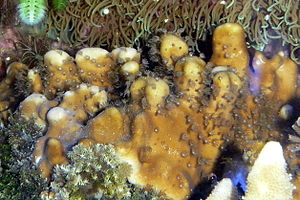Blue coral
| Blue coral | ||||||||||||
|---|---|---|---|---|---|---|---|---|---|---|---|---|

Blue coral in an aquarium |
||||||||||||
| Systematics | ||||||||||||
|
||||||||||||
| Scientific name | ||||||||||||
| Heliopora coerulea | ||||||||||||
| ( Pallas , 1766) |
The blue coral ( Heliopora coerulea ) lives in coral reefs of the Indo-Pacific , looks like a hard coral , but is the last survivor of a group of Octocorallia , which was initially only known to be fossilized . Very similar forms with an age of 100 million years have been known from the Tethys coasts of Europe, Africa and India since the Cretaceous . It is one of two species of Octocorallia that form a massive skeleton made of calcium carbonate . The blue coral occurs in the Indo-Pacific, only in regions that have a constant temperature of 22 ° C or more.
features
The colonies can form huge blocks with plate-like branches, a height of half a meter and a diameter of seven meters. When the blocks reach the surface of the water, the dry falling tissue dies and micro-balls are formed .
Outside, the colonies are brown in color, the skeleton is colored blue due to various iron salts. The polyps of the blue coral are small, only one millimeter in size and, like all octocorallia, have eight pinnate tentacles . The skeleton is not, as in other Octocorallia, formed by sclerites , which are then connected to one another, but by fibers made of aragonite , which fuse into thin plates. The polyps sit in niches in the skeleton, are connected to one another by stolons and encapsulate the niches with further skeletal growth by transverse walls downwards. In addition to the polyp niches, there are also smaller, pore-like niches into which the stolon tissue grows root-like downwards. The living tissue forms only a very thin layer on the aragonite skeleton.
The blue coral lives in a symbiosis with zooxanthellae , small, unicellular algae from the group of dinoflagellates , which supply the coral with nutrients.
Systematics
Because of its uniqueness, the blue coral is traditionally placed in its own order, the Helioporacea . Phylogenetically it is the sister species of a clade from the sea feathers (Pennatulacea) and the gorgonian family Ellisellidae . The clade formed by these three taxa is the sister group of the Calcaxonia , a suborder of gorgonian-like corals. A second more recent Heliopora species was described in January 2019 . Heliopora hiberniana colonies are more finely branched and have a white or whitish-blue skeleton.
literature
- Volker Storch, Ulrich Welsch: Systematic Zoology , Fischer, 1997, ISBN 3-437-25160-0
- Gruner, H.-E., Hannemann, H.-J., Hartwich, G., Kilias, R .: Urania Tierreich, Invertebrates 1 (Protozoa to Echiurida) . Urania-Verlag, ISBN 3332005014
- SA Fosså, & AJ Nilsen: Coral Reef Aquarium , Volume 4, Birgit Schmettkamp Verlag, Bornheim, ISBN 3928819054
Web links
- Heliopora coerulea inthe IUCN 2013 Red List of Threatened Species . Listed by: Obura, D., Fenner, D., Hoeksema, B., Devantier, L. & Sheppard, C., 2008. Retrieved December 12, 2013.
Individual evidence
- ^ Catherine S. McFadden, Scott C. France et al. a .: A molecular phylogenetic analysis of the Octocorallia (Cnidaria: Anthozoa) based on mitochondrial protein-coding sequences. In: Molecular Phylogenetics and Evolution. 41, 2006, p. 513, doi : 10.1016 / j.ympev.2006.06.010 .
- ↑ Zoe T. Richards, Nina Yasuda, Taisei Kikuchi, Taryn Foster, Chika Mitsuyuki, Michael Stat, Yoshihisa Suyama, and Nerida G. Wilson. 2018. Integrated Evidence Reveals A New Species in the Ancient Blue Coral Genus Heliopora (Octocorallia). Scientific Reports. 8, 15875. DOI: 10.1038 / s41598-018-32969-z